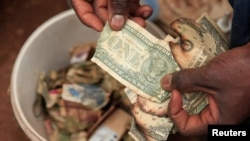A dab of glue and this ten-dollar note is "as good as new".
So says black market trader Cuthbert Gudza as he sits patching up currency in Zimbabwe's capital Harare.
“I am a potato seller but I saw buying torn US dollar notes as another business opportunity."
Zimbabwe is a dual currency economy following the collapse of the Zimbabwean dollar in 2009.
Zimdollars were reintroduced in 2019, but locals generally rely on the greenback for daily transactions.
However, with U.S. currency in short supply, grimy old notes are making a comeback
Gudza buys well-worn cash, that he says would be rejected at supermarkets, at a discount.
He then fixes it up and sells for a profit on the black market.
“When a person brings their torn dollars, I pay $600 Zimdollars for every $1. I will then sell it and get $800 Zimdollars. There are others who do not want money, we give them what we sell, bananas, oranges, apples or potatoes. I gain at least $0.20 or $0.30 per every dollar."
Zimbabwean banks are mandated to accept soiled money in exchange for crisp notes.
The central bank has asked citizens make that exchange using official channels.
But, having lost their savings to hyperinflation, many mistrust the financial system and prefer black market traders.
Whilst not as severe as the crisis under former President Robert Mugabe, Zimbabwe's economy is again struggling.
Inflation is in the triple digits, unemployment is high and the local currency has been sliding.
For those like Gudza, breathing new life into old dollars is just one way to survive amid the financial onslaught.




